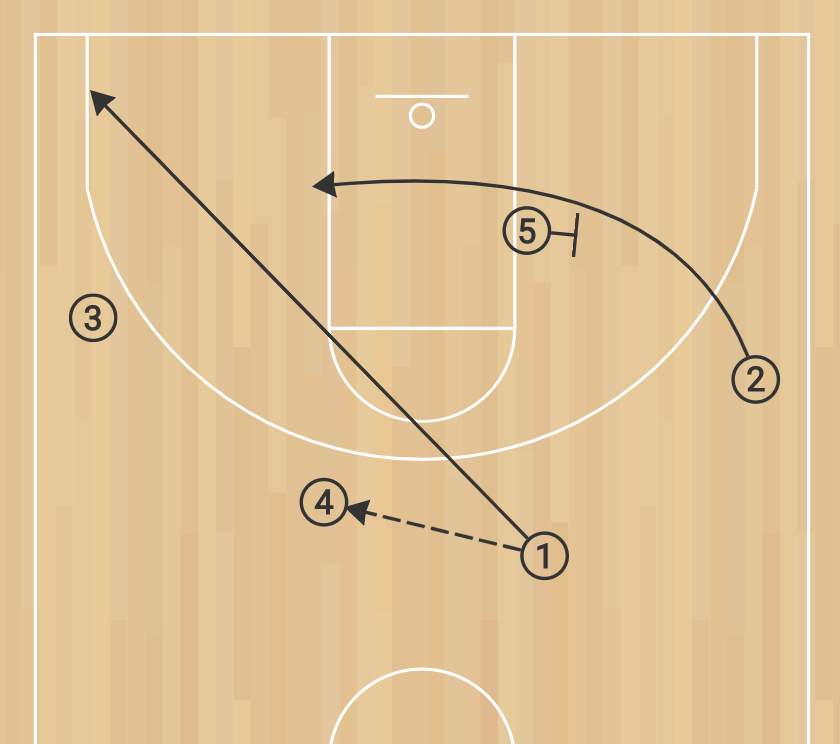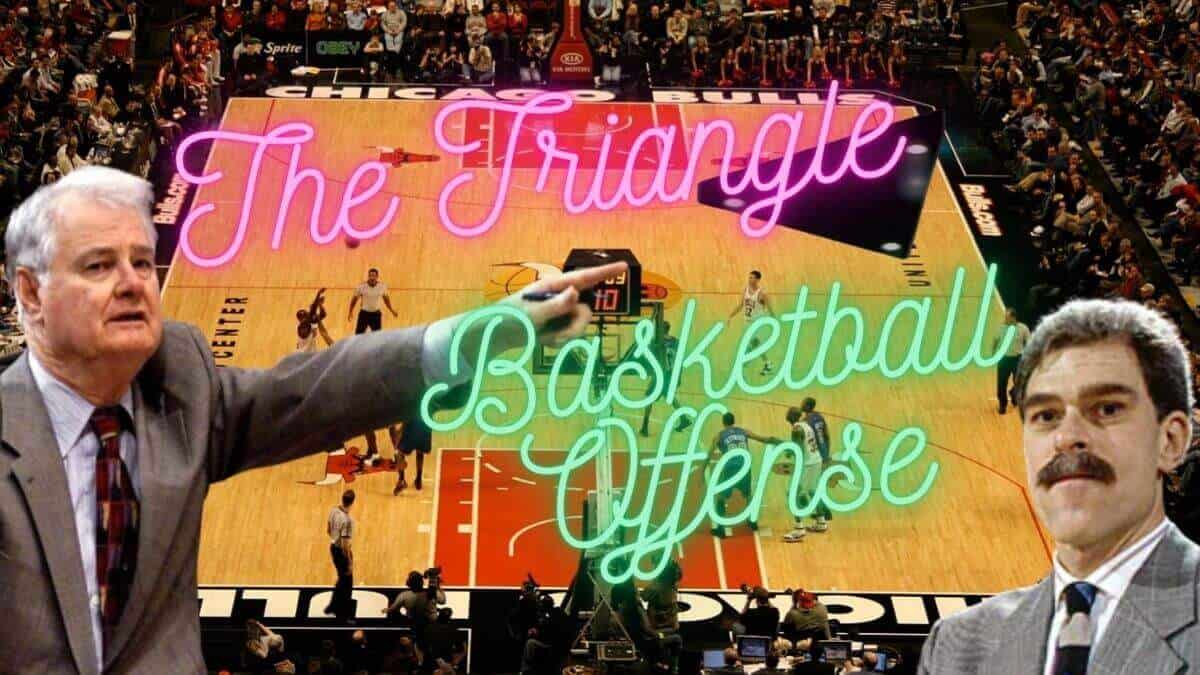I mention a specific book in this post. It’s a little tough to find, so we’ve provided links. When you make a purchase through these links, we earn a commission through Amazon. Learn more from our affiliate disclaimer.
One of the most infamous strategies in basketball offense, the Triangle Offense first emerged in the 40’s but was popularized by the Chicago Bulls during their championship run in the 1990’s.
This is a classic basketball strategy that creates scoring opportunities for every position. It can be fun to experiment with simplified versions of the triangle on youth teams. But this is an advanced strategy that can take many years to master.
The guy who created this offense laid it out in his own words and there’s just no amount of Youtube videos and blog posts that can offer that. So if you’re looking to dive deep, you gotta get the book.
Still, we’re going to try our best to catch you up on this beautiful offense.
The underlying theory here is that moving through cycles of triangular player positioning brings a naturally effective spacing to your offense. Of course, the devil is in the details. Some of the greatest minds in basketball history have hung their entire offensive schema on the theories of the triangle offense, and in some cases that has payed off.
In this post we’ll discuss the triangle offense in detail and its advantages over other offensive strategies. We will also look at how it has evolved over the years and how it is used in modern basketball.
How does a triangle offense work?
The triangle offense seeks to position three players in a triangle formation, 15-10′ in length, to one side of the court. The offense often initiates with a guard passing to the wing and cutting to the strong-side corner. With the post on the strong-side block, a triangle is formed with the guard, the post and the wing. Countless progressions evolve out of this formation.
The Triangle Offense Entry

Launching the offense means assembling your triangle. This will typically function as a 4-out offense with the post on the block. There are 2 classic entries. One goes to the post side, the other goes away.
Post side entry
Going towards the post, the ball handler passes off to a wing at the sideline. They then sprint into the corner, leaving as many defenders stuck along the way as possible.
This move looks a lot like a pistol maneuver. It should. The pistol is a common sub set of the triangle offense. You’re basically just rushing the transition and jumping in before the post is set low, hoping that the defense is unprepared.
Opposite side entry

Running opposite the post, the path is a little more complicated. You need to move that third point of the triangle over from opposite court.
The solution ends up being simple, and there’s something kinda beautiful about this action.
First, the ball handler drops off to the opposite side and sprints to that opposite corner. Now, you could just jump the post to the opposite block, but the prettier option is to run the weak side wing off of a post screen to the opposite block. This should jam up the defense a little better.
As the triangle comes together, the ball handler passes in. The easiest route is likely dropping off to that nearest perimeter player, but there are always options.
Triangle Offense Execution
So getting into the triangle is pretty straightforward. Of course, you can definitely make that part complicated too if you like. But let’s take a look at what you want to do once you’re there.
I mean, we could go on all millennia. If you want to go deep here, again, I have to recommend getting it right from the wellspring itself. But I can catch you up on some of the basics.
The ideal situation in the triangle is a pass to the post for a scoring opportunity. This would set you up steady on the low block with 2 options there to rush the paint or try and sneak back out.
But the weak-side players are there as well. If the pass to the post isn’t safe, the weak-side wing should be hanging out around the high post as another outlet. This cross-court pass shifts the triangle and sets up a whole new set of options.
In this way, you’re always looking to work to the inside of the triangle. But outlets will become available and allow you to shift the triangle around the floor until you find a hole in the defense.
Advantages and Disadvantages
We’ve seen this strategy win championships, an awful lot of championships. Elements of the triangle system can be spotted in just about any game. his strategy is fun and effective, and really any player and fan should have some basic familiarity with it if they want to grasp the evolution of this game.
Advantages
- Promotes ball and player movement, creating open shots.
- Generates spacing. A double team is 15-20′ from a matchup.
- Any player can pass or shoot at any time, keeping the defense on their toes.
- Involves the entire team, which is great for comoraderie.
- The spacing of the triangle makes a double-team extra risky.
Disadvantages
- Dependent on strong fundamentals.
- It’s fairly complex.
- Doesn’t create a lot of pick and roll opportunities.
The History of the Triangle Offense
After playing his senior year with Hall of Fame coach Sam Barry at the University of Southern California in the 1940’s, Tex Winter went on to coach for Marquette. For his offense, Tex began to build off of a set that he was familiar with from USC, which they had called ‘center option’. In his time with Marquette, and later Kansas State, Tex took refined this into what we now recognize as the triangle offense.
Winter would eventually move on to the Bulls as an Assistant Coach. When Phil Jackson showed up in 1989, he embraced the triangle, and allowed Tex and his systems to thrive. Jackson would later bring the system with him to the Lakers, cementing the importance of this offensive play set in NBA history.
The triangle offense is foundational to Jackson’s incredible run of 11/20 championships. You can’t exactly dismiss the players: Kobe, Jordan, Rodman, Gausol, Shaq, and on and on. Still, all of these teams were operating on triangle offensive concepts.
Here’s a really cool clip of Jackson running through some triangle film from his time with the Bulls.
Use of the triangle has evolved over time. It still makes the occasional appearance in the NBA, though it’s fallen somewhat out of favor.
Triangle Offense Drills
Hate to beat the horse here, but again, that book I mention, it’s got a ton of great drills. These are, quite literally, drills used to get the Bulls and the Lakers up to speed on the triangle.
And if you just want a quick introduction to the drills in the book, I took a few of them, simplified them a little and packed them into a separate article on triangle offense drills.
Still, for context, I’ll describe a basic drill here. Something simple that works on triangle entry. Entry should feel like second nature if you’re running a triangle offense as a core philosophy.
Put a cone on each block, representing an imaginary post on either side. Split up into two lines near half court, in line with the blocks. Send two player off to the wings. The ball goes to the head of one of the lines.
On the whistle, the ball handler dribbles off down the court, paired off with a player from the opposite line. This is your 4-out rolling in.
As they approach the wings, you call out the direction. Players run into triangle formation on the designated side, following the prescribed entry paths. Pass back to the head of the line, or just launch the next group with a new ball while the previous round is heading back to the line.
Once the entry sequence starts to look smooth, rotate sides to get everyone comfortable attacking from either side.
Defending Against the Triangle Offense
The various options of the triangle offense are intended to respond to the defense as it is read. So a clever team that is well-versed in their system should be ready with a response to whatever you throw at them.
In practice, this is rarely the case. Combat a team that has their offense down cold by having your defense down cold. Whatever system you employ in defense, it can be used to combat the triangle.
But let’s focus on the weaknesses…
Block the entry
Recognize those entries. Make sure your team is clear on how the triangle operates, but pay particular attention to how it starts.
Once the offense passes to the wing, you should anticipate the cut to the corner. If you’re opposite the post, you can also anticipate that screen on the post. Get on the other side of the post and cut it off. Disrupt the cut and you disrupt the triangle.
Avoid the double-team
Part of the reason that this system worked so well for Phil Jackson is that he was able to run it with some of the most double-team worthy players in basketball history. A core concept of the strategy is that it spaces the offense. If a player is left uncovered, they are left way uncovered.
You need to do what you can to avoid that double-team. If your opponent has a problematically good player, you might want to consider the box-and-1 if your team can handle it. Lock up your best defender on their best scorer and let the box handle the rest.
Keep the pressure on
Make it difficult for them to keep the ball moving. Spot the triangles and move quick to isolate the corresponding outlets. Get in front of your matchups and read those pivots.
One of the great things about the triangle is that it simplifies the logic of play. But that also means that you can potentially get ahead of the offense. You know your matchup is part of the triangle, then read the ball handler.
Be Disruptive
The last thing we need to do when defending against the triangle offense is to be disruptive. Get in the passing lanes and cut off the ball movement. And get aggressive on boxing out and rebounding to take away easy shots.
If you need some more options, hooptactics has a pretty good list of X’s and O’s for counters.
Conclusion
The triangle offense can keep you busy for the rest of your life. There’s some suggestion that it just won’t function at the higher levels in modern basketball. And sure, we haven’t seen it fully embraced by a dominant team since the Phil Jackson Lakers era. But the triangle is still very much alive.
I personally love this defense for young teams. It may be a little much for a young player to fully wrap their head around, but that just means it’s a challenge. And there are plenty of options to simplify things.
The real beauty here is the way the triangle sets encourage team play. A system where a shot or a pass can occur at any moment is exciting and engaging. This is a great strategy for getting everyone involved.
